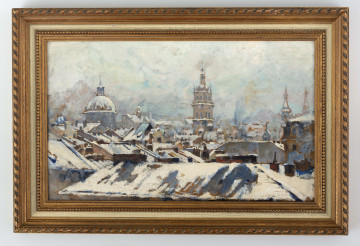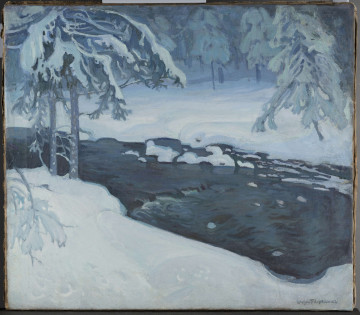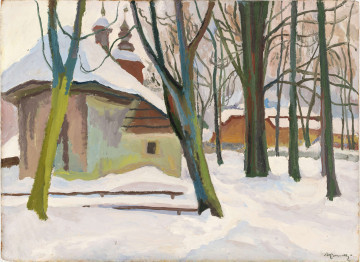
View of Lviv
1923
National Museum in Lublin
Part of the collection: Polish symbolic painting from the beginning of the 20th c.
Tadeusz Pruszkowski actively participated in Polish inter-war cultural life as an artist, critic and teacher. He took part in the First World War as a soldier of the Legions. He studied painting under Konrad Krzyżanowski at the Warsaw School of Fine Arts. In his work, he presented the current of the creative return to tradition, called the new classicism, which drew patterns from the art of the masters of the Renaissance and Baroque, distancing itself from modernist, progressive postulates. He was a member of several groups, including ‘Young Art’ and ‘Rhythm’. He painted mainly portraits and still lifes. In Kazimierz on the Vistula River, ‘Prusz’ ran a painting studio, the participants of which established the Brotherhood of St. Luke. He died in 1942, shot by the Germans.
Several symbolic works, referring to the war situation of the country at that time, come from the early period of his artistic work. Their theme was motifs and characters from the Piast era of Poland, shrouded in the aura of the legend of the beginning of the nation and its founders. These included the paintings Śpiący Rycerz [Sleeping Knight] and Piastuny [Custodians], made for a competition held by the Zachęta Society. Both were highly appreciated; for the second one, the painter received the first prize in 1917.
Piastuny is a suggestive representation, monumental in composition and expression. It contains only the necessary elements which build up the complex content, imposing themselves with the force of direct presence. The use of two-colour contrast, dark brown and subdued white, perfectly intensifies the effect. The image field is filled with powerful silhouettes of three warriors armed with ancient weapons. They are standing in the forest among tall firs and spruces covered with a thick layer of snow, above which the frosty sky is golden. The two older men are the title piastuni – the young man's guardians and teachers. Under their tutelage, the boy learns the art of war. He becomes acquainted with danger on the hunt, tracking down the enemy as the men tread carefully, watching and listening.
The scene contains several complementary meanings. The warrior-Piasts are at the same time a symbolic personification of the Slavic ancestors – the Piasts. The exposed detail of their clothing, such as the elaborate belts, draws attention to the theme of mountains and the iconography of mountaineers. The trail leads to the then-living legend of knights sleeping in the Tatra Mountains, perfectly reflecting the atmosphere of expectations, independence aspirations and national hopes.
Bożena Kasperowicz
Author / creator
Dimensions
cały obiekt: height: 199 cm, width: 249,5 cm
Object type
painting
Technique
oil technique
Material
canvas, oil-based paint
Creation time / dating
Creation / finding place
Owner
The National Museum in Lublin
Identification number
Location / status

1923
National Museum in Lublin

1920
National Museum in Lublin

1st half of the 20th century
National Museum in Lublin
DISCOVER this TOPIC
Museum of King Jan III's Palace at Wilanów
DISCOVER this PATH
Educational path